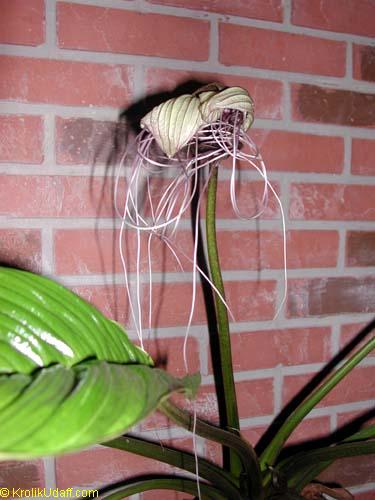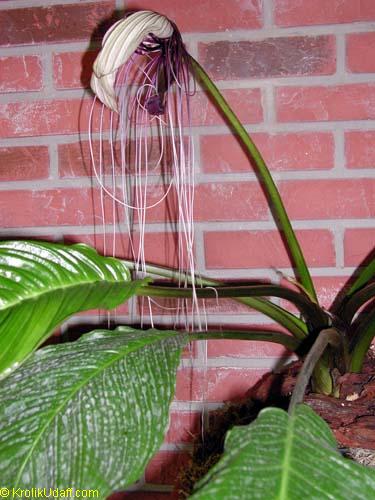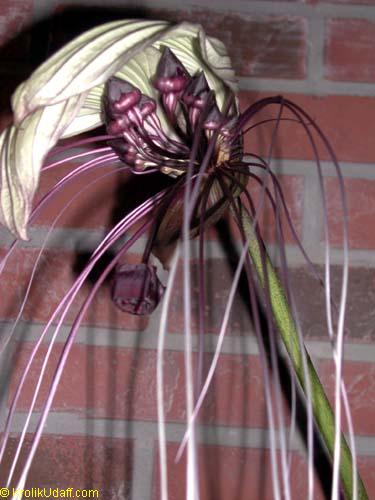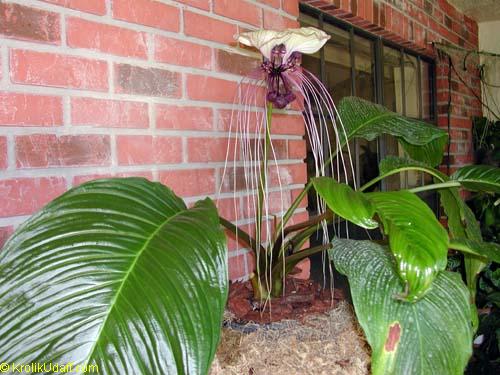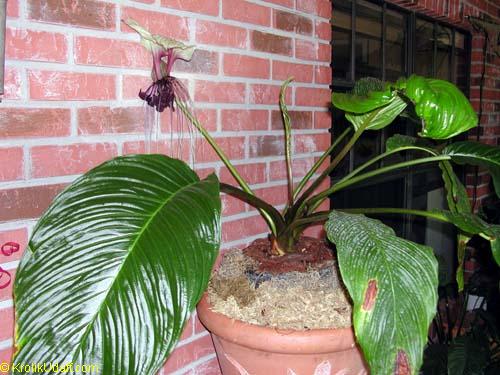Tacca Chantrieri and Tacca Nivea - Bat Head Lily, Bat Flower, Devil Flower
click on image to enlarge
Tacca Nivea:
Family: Taccaceae
Origin: Malaysia
Curious, bat-like inflorescence both in shape and color, with wide spreading,
wing-like bracts of rich maroon-black, accompanied by long trailing filaments
or "whiskers"; the small black flowers are succeeded by heavy berries;
corrugated olive-green leaves with oblique base. These are interesting, evergreen,
perennial and herbaceous plants that grow wild in many tropical climates. They
can be grown in humid, tropical greenhouses. T. pinnatifida (leontopetaloides)
contains a lot of starch in its rhizomes, which, when extracted and prepared for
food, is called East Indian Arrowroot or South Sea Arrowroot. The kinds in cultivation
have creeping rhizomes or rootstocks and large, oval, crinkly foliage. The purplish-brown
flowers are produced in bunches atop long, thick stems, 18 to 24 inches high.
Long whiskers are suspended from the lovely flowers.
Propagation
The rhizomes can be divided at repotting time in the spring. Growing Tacca from seed is not for the beginner - they require a lot of extra care.
Soak the seeds 24 hours in warm/hot water (hot enough that you can put your hand in). Use a thermos bottle to keep the water hot during this time.
Sow in trays, pots, etc. using a good seed starting mix in a propagator or warm place to maintain optimum temperature of 80-85F. It is essential that the soil temperature is high and kept steady. Use regular seed flats and clear plastic domes. Place the flats on a propagation (heat) mat for additional bottom heat.
Sow 1/16 inch deep in good seed starting mix and seal the container using a polythene bag, cover with plastic wrap or use a clear dome to keep moisture in. Do not use regular potting soil - it's too heavy and does not allow the seeds to breathe or water to drain properly. Heavy soil can also cause the seed to damp off. Sprinkle a little bit of sphagnum moss on top to help retain moisture on the seed and mist them daily with warm to room temperature water. Bottom water can also be added to help promote good root structures, but don't drown them!
Germination can take from 1-9 months so be patient. Don't toss out your seed beds thinking they won't germinate!
Care of Seedlings
Ttransplant seedlings when they are large enough to handle into 3" pots using a good free draining compost with 10% added grit (sand). "Washed" Carpetner's Sand can be purchased at any home improvement store - be SURE its washed or the salts will damage your plant. Do not use beach sand. During the growing season (late spring to late summer) the plants need to be watered very regularly and the compost must we well drained. For fertilizer use Miracle Grow mixed 1/4 teaspoon to 1 gallon of water. Pot as required into larger pots, eventually to 8" pots. Give very little water through the winter and provide a temperature of 60-65 F. Summer temperature should be 75-85 F. Re-pot in February/March if needed and keep shaded from sun. As with any tropical, give the occasional mist spray through the summer.
Tacca's are known for damping off. Remember to use a good seed starting mix that has been treated for damp-off. If it still appears that your tiny seedling is failing, sift a small amount of good potting mix around the tiny stem for support, being very careful not to damage the stem! Continue with bottom heat and a covered dome until they have at least their second set of leaves.
Potting
New leaves will appear curled and with a spinach texture. This is normal. A good idea is to put the plant in your bathroom, turn on the hot shower and let the room steam up. Close the door and leave the light on overnight. This will perk up a Tacca quicker than anything. They love the moisture and heat! Tacca's are tropicals! They love the heat and moisture but they can be grown indoors in colder climates. They will require additional care to keep them warm and moist.
As soon as new growth begins in the spring, remove the old, loose soil from their roots and then repot in a mixture of peat moss and sand. The pots need good drainage. While they are growing vigorously in the summer an abundance of water is applied, but throughout the winter, less water should be given. Established plants that have filled their pots up with roots will benefit from regular applications of dilute liquid fertilizer. The minimum winter temperature of the greenhouse should be 55 F; from spring through fall (the time that they're actively growing), the minimum temperature that should be maintained is 60 to 65 F.
Seeds
After the Tacca blooms, it will develop seed pods. These pods will remain on the plant for quite a long time. Once they dry out or fall, remove them and split them open to remove the seeds. Let the seeds dry only a few days. If a pod is accidently knocked off while it is still mushy, place it on a saucer and let the pod continue drying before opening it up to harvest the seeds. The fresher the seed, the better the germination. The age of the seed is an important factor in germination. One pod may have 5 seeds while another - 50...
Species:
Tacca chantrieri (the Devil Flower, Black Tacca)
Tacca cristata aspera
Tacca esquirolii
Tacca gaogao
Tacca hawaiiensis
Tacca integrifolia
Tacca involucrata
Tacca laevis
Tacca leontopetaloides
Tacca minor
Tacca nivea (White Tacca)
Tacca paxiana
Tacca pinnatifida
Tacca plantaginea
Tacca subflabellata
Tacca chantieri:

